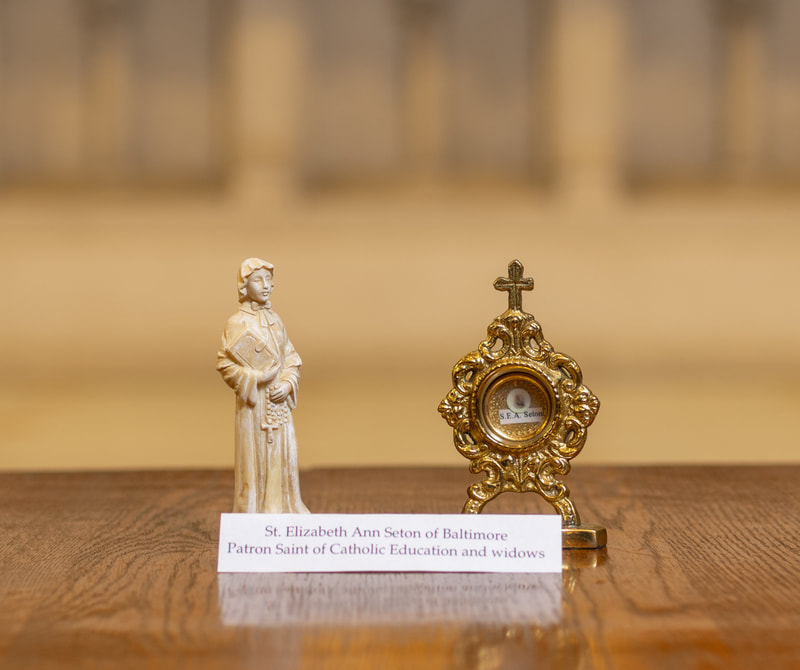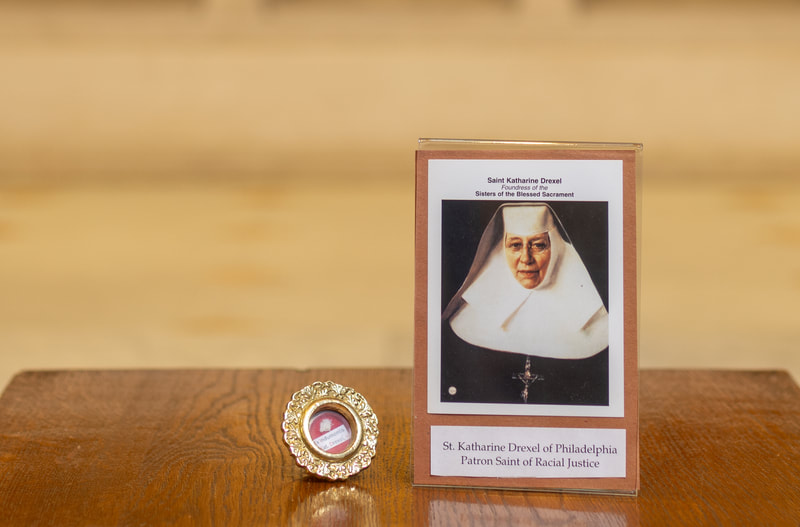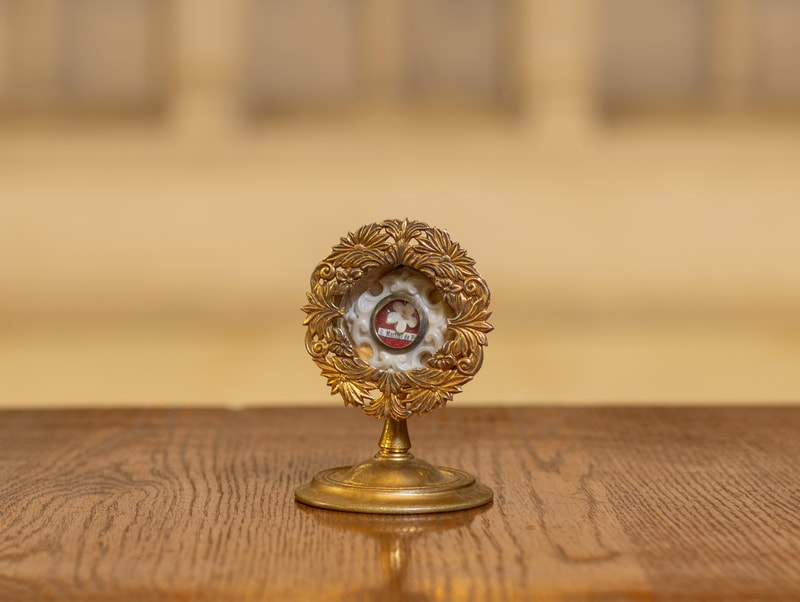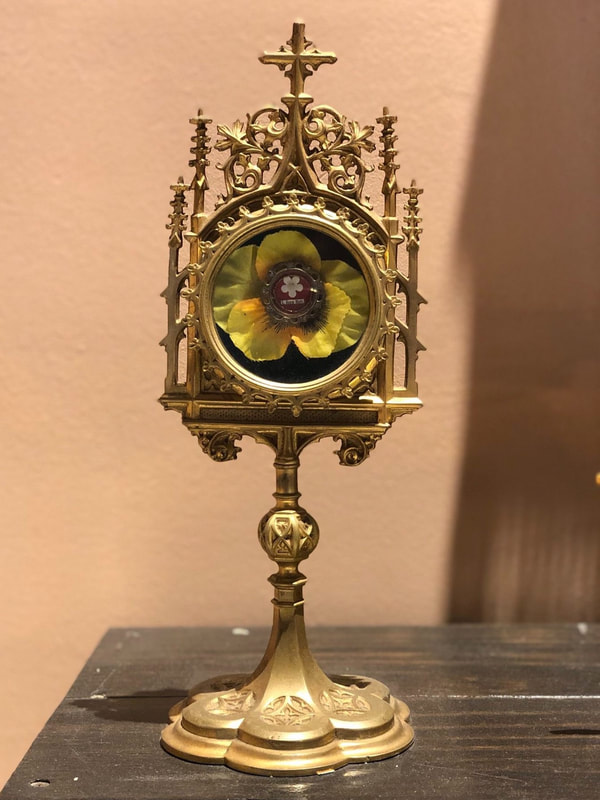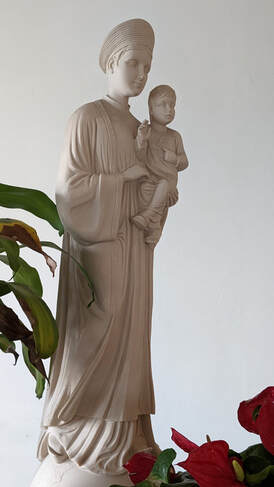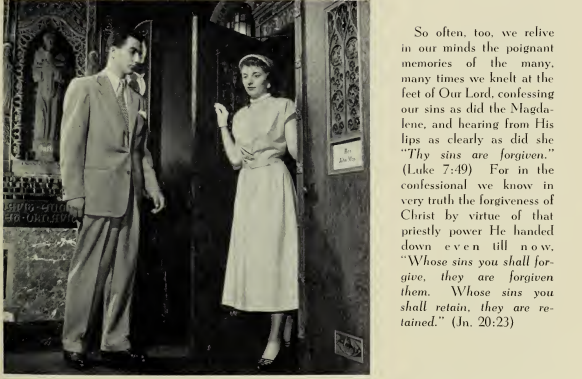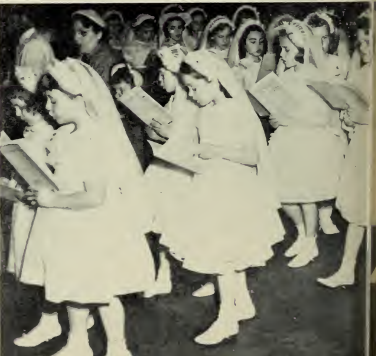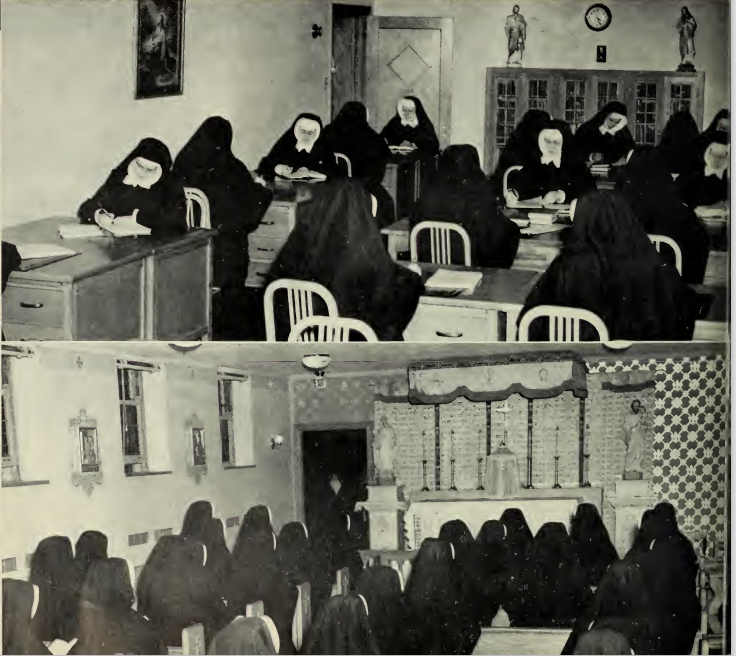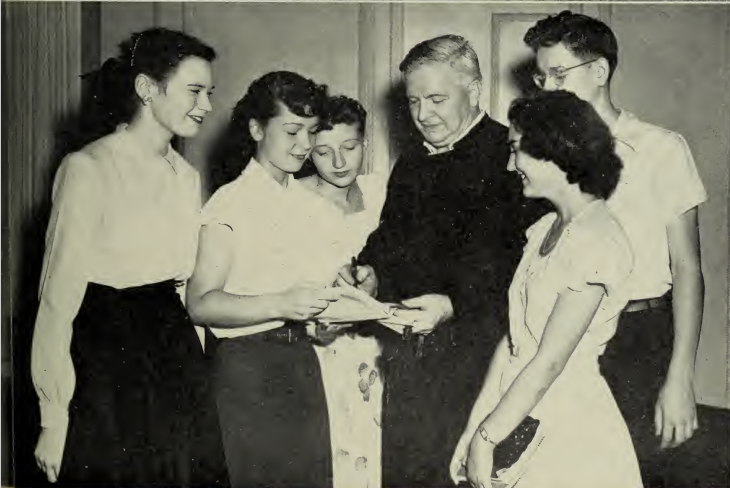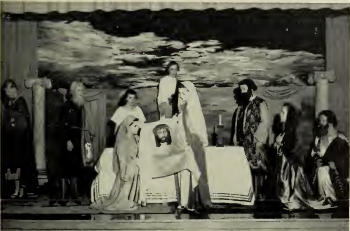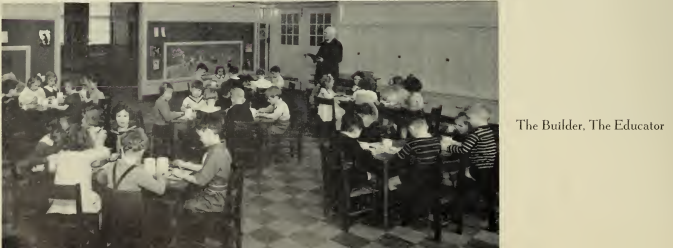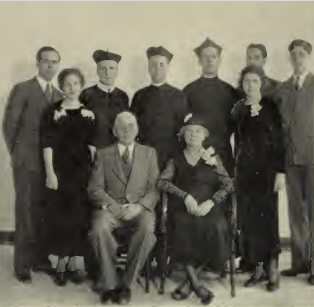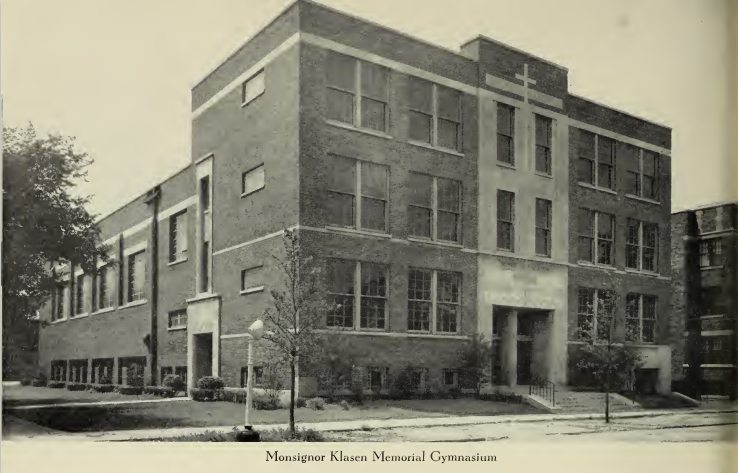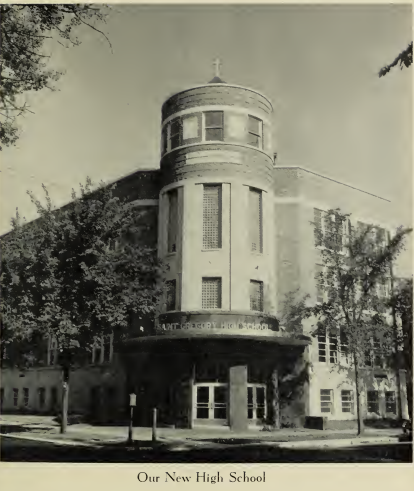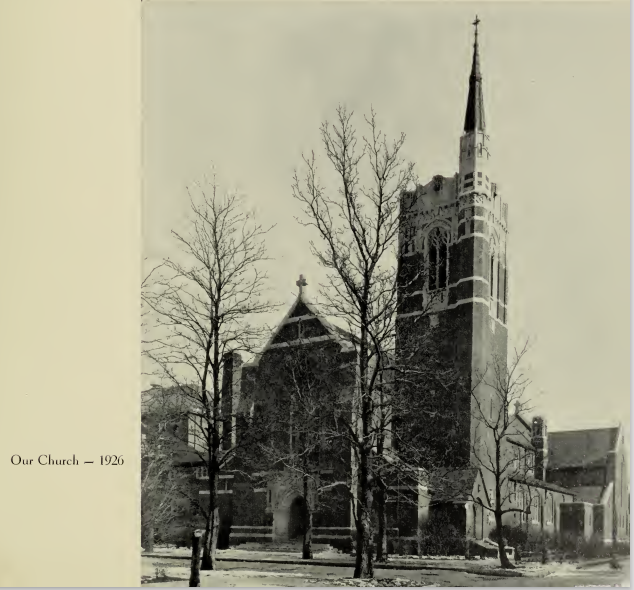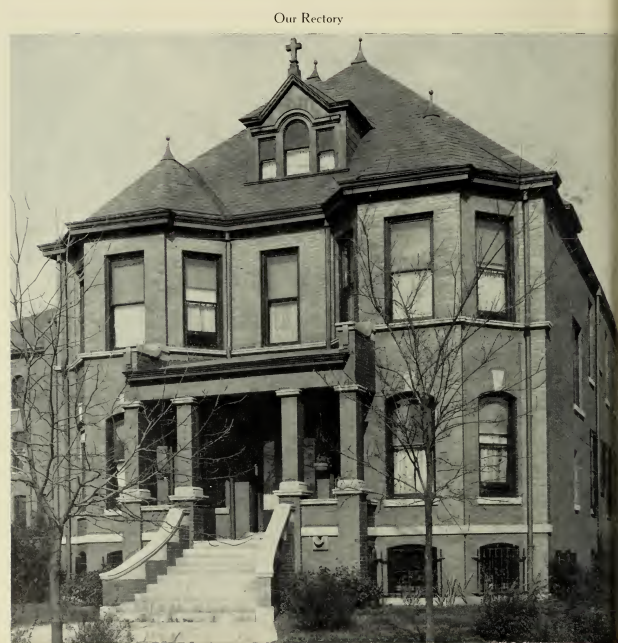|
On April 30, students from Loyola University unveiled their digital history exhibit which explores the legacies of the three parishes – St. Thomas of Canterbury (1916), St. Gregory the Great (1904), and Saint Ita (1900) – which make up our new parish. The students and their professors joined parishioners in Jubilee Hall for the presentation. Students shared highlights from their research which included archival documents, interviews with long-time parishioners, and visits to each of our churches. Attendees also had an opportunity to ask questions and share their own stories. We are very grateful to the students for the time they spent documenting our community’s history and how thoughtfully they treated the project. Soon their final digital exhibit will be ready to share so you can see their work for yourselves! Event Photos*Photos courtesy of volunteer Dina Kwit Research PhotosOur parish has a rich treasury of over 50 relics. The collection speaks to the history of our three churches, our stewardship under the Conventual Franciscans, and our new identity as Mary, Mother of God Parish. These relics are on display across our parish and can be easily viewed in person or you can explore them in more detail in the new digital gallery below! Following the main gallery, photographs are further grouped into Franciscan Saints, Saints of Mercy, and Parish Church Patrons (click "read more"). Click on the photograph to expand it. You can read more about the Church's tradition of venerating relics here! May is traditionally the month of Mary, with May crownings and traditions to honor our Blessed Mother. During this month, we strongly encourage all our parishioners to explore the depictions and images of Mary at all three of our parish! Today, we bring you the images of Mary at St. Thomas of Canterbury Church (4827 N. Kenmore). St. Thomas of Canterbury is notable for its shrines of martyrs throughout the world, but Mary features prominently throughout the church as well. Mariam Dearit Mariam Dearit is venerated by Catholics in Eritrea, with a major festival in her honor at the end of the month of May. The members of the Holy Family Eritrean Community celebrated in her honor on May 6, with Mass in the Ge'ez a procession and reception. Our Lady of Walsingham Our Lady of Fatima Our Lady of Lavang Our Lady of Gaudalupe Our Lady of Perpetual Help Mary with St. Anne
The history of fifty years of Catholic Faith in a large city neighborhood — published by the grateful Parish of St. Gregory the Great, Chicago, Illinois, in joyful celebration of its Golden Jubilee - November 14, 1954 PeopleBuildingsIn the late Medieval period, St. Thomas of Canterbury was the most famous martyr of the Church—murdered by King Henry III’s knights to “rid him of that meddlesome priest.” Because of this, St. Thomas of Canterbury church has several shrines to martyrs: The Martyrs of Vietnam, of Laos, of Korea, of Japan, San Lorenzo Ruiz of the Philippines, and Friar Casimir Cypher, the Conventual Franciscan priest from Wisconsin murdered in Honduras.
To further honor the martyrs of the Church, a Shrine to the Martyrs of England and Wales has been created by Joe Malham of Trinity Icons. The center of the Shrine is a statue of Our Lady of Walsingham, who appeared in England to Lady Richeldis in 1061. A shrine was built on the spot and it became the center of Marian devotion in England—Thomas of Canterbury himself visited on many occasions. As part of the Reformation, Henry VIII destroyed the shrine and statue. In 1897, Pope Leo XIII restored the shrine and had a statue made by the artists of Oberammergau, Germany, based upon images of the original statue. Our statue of Our Lady of Walsingham, also from Oberammergau, is seated upon a shelf supported by two Augustinian friars—the religious Order that served the original Walsingham shrine. A tapestry of St. Margaret’s Brocade (a design of the Tudor period) hangs between the two friars. Beneath Our Lady of Walsingham hangs a print by Daphne Pollen titled “The Forty Martyrs of England and Wales," commissioned as part of the celebration of the martyrs' canonization in 1970. Featured prominently at the center is St. Margaret Clitherow, who was pressed to death for hiding Catholic priests during the persecutions in England, which roughly spanned from 1535-1679. On either side of “The Forty Martyrs of England and Wales” are original paintings by Joe Malham. To the right one finds a portrait of St. Thomas More and St. John Fisher, executed by Henry VIII. They have been described as the “Peter and Paul” of English Catholicism. To the left, one finds St. John Jones (+1598) and St. John Wall (+1678), the two Franciscan friars among the forty martyrs. They were hung, drawn and quartered. Beneath the print and paintings, there is an altar with the risen lamb, bearing the flag of St. George. The wall is painted red to represent the blood of the martyrs, and is adorned with gold Canterbury crosses. Above the shrine are the words “Martyres Anglia et Cambria”—Latin for the Martyrs of England and Wales. Holy Martyrs, pray for us! There is a centuries-old tradition — particularly in the churches of Great Britain and New England-- to paint church doors red. There are many possible reasons. Red symbolizes the Blood of Christ, through which we enter into the Church. Red also signifies the tongues of fire at Pentecost, a sign that the Holy Spirit is within the doors. Red doors also recall the sprinkling of the door lintels of the Israelites with the blood of lambs on the night of Passover. Beginning in the Middle Ages, red doors indicated a place of sanctuary which offered physical safety from outside evils.
Our parish’s former artist-in-residence, Joe Malham of Trinity Icons, chose the shade of red from the palette of Augustus Pugin, the master of 19th Century Gothic Revival design. Cardinal Mundelein, in designing St Thomas of Canterbury Church, based it on a Connecticut Meeting House to reference the New England roots of American Christianity. By painting the doors red, we honor Cardinal Mundelein’s inspiration.  'God is telling me we should start a soup kitchen' The origins of the Soup Kitchen at St. Thomas of Canterbury are murky enough that a flier for the 10th anniversary featured “To Tell the Truth: Who Started the Soup Kitchen?” as part of its entertainment. But whatever the specifics, most agree that Terry Gates, who lived at the St. Francis Catholic Worker House in Uptown in 1978, was the one who first had the idea. The Catholic Worker Movement was founded by Servant of God Dorothy Day and Peter Maurin, designed to facilitate direct practice of the spiritual and corporal works of mercy by sharing the lives of the poor, most notably in houses of hospitality that provided shelter for those in need. Terry had originally come to the house in Uptown as a guest after a car accident and family estrangement, and in the words of Jim Eder, who was also living at the Catholic Worker house at the time, “she became our poster girl, as she healed physically, spiritually, mentally.” She approached Jim with the idea for the soup kitchen first, arguing that it was in the tradition of soup lines begun by Catholic Workers during the Great Depression. He pointed out that the house already had about 20 guests to its five members, who could “barely keep [the house] open.” “She said, ‘No, Jim, you don't understand, God is telling me we should start a soup kitchen,’” Jim recounted. “So in my great love for the poor and my kindly spirit and my wonderful nature and my generous spirit, I said, ‘Well, you and God are going to have to do it, because it's a dumb idea, and it'll never work. And you can't do it.’ And then she said, ‘Well, I'm going to go down and ask Fr. Rochford if we can use the [St. Thomas of Canterbury] church basement.’ And I said, ‘Good!’ because I figured: Oh, the priest'll kill this.” Fr. Rochford, who was pastor at St. Thomas of Canterbury a couple blocks north of the Catholic Worker House, did the opposite; he opened the basement for operations. By Joseph Malham Trinity Icons God’s providence, like His grace, knows no boundaries and always manages to surprise us in the varied ways in which it is manifested. The way churches in Chicago were conceived and created is no exception. There are churches organized along ethnic lines and proximity to factories and stockyards. There were also churches built to reflect the homeland of the community and the wealth they were blessed with in the New World. However, St. Thomas of Canterbury in the heart of Uptown is the only church in Chicago history to have originated in a snowstorm.
A severe blizzard in the winter of 1916 kept numerous Catholics in the Wilson Avenue District (soon to be known as “Uptown”) from reaching either St. Ita in Edgewater or Our Lady of Lourdes in Ravenswood. A compromise in the form of a new church halfway between the two was proposed to the new Archbishop of Chicago, George W. Mundelein. Find 500 families who could be potential parishioners, His Excellency said, and you have your church. In less than a week the requisite number of families had been found, and St. Thomas of Canterbury Church became a reality. It was fitting that St. Thomas of Canterbury began as a response to the spiritual and practical needs of the community. That is a spirit of spiritual care and communal outreach to a wide and diverse group of people that continues to this day. "A Medieval jewel in a modern setting..." Church Architecture History
St. Gregory the Great Church has served the north side of Chicago since 1904, when the Luxembourgers of the neighborhood petitioned for the creation of a new parish. Education is at the heart of St. Greg’s — from the magnificent Norman Gothic church that teaches the faith through its stunning altars, windows and very design, to the countless graduates of its elementary and high school. Officially classified as a church in the Norman Gothic style (Norman referring to the French influence on English architecture following the Norman Conquest of England in 1066), St. Gregory's is a direct descendant of the great flowering of churches in the Medieval style that began in the early 19th Century. The movement, called Gothic Revival, began in England as a spiritual/cultural revolt against the Industrial Revolution and embraced not only architecture but art, poetry, literature and music as well. Its proponents included the author Sir Walter Scott, artist and critic John Ruskin, the designer William Morris and the architect A.W.N. Pugin. It was Pugin who truly reinvigorated the nation with the spiritual and the artistic aesthetic of the Middle Ages, and his churches and public buildings (including the Houses of Parliament) stand as some of the finest architecture of the 19th Century. St. Gregory the Great Church is one of the finest examples of Gothic Revival architecture in the Archdiocese of Chicago, and as such acts as a complete spatial instruction in the truths of the Christian faith. Everything, from the paintings and sculptures to the architecture elements itself, not only tells a story but invites us deeper into the heart of the mystery that is Christ's Church. The journey into St. Gregory's Church is a journey into life, death and re-birth, from Alpha to Omega, from darkness to light. Msgr. Michael Klasen, the founding pastor of St. Gregory the Great Church, created a booklet entitled The Church Beautiful in which he explains the symbolism and meaning of the various shrines, stained glass windows, and other liturgical decorations that can be found in our Church. Click on the following link to learn more about our Church Beautiful. In 1942, Monsignor Michael Klasen, the founding pastor of St. Gregory the Great, published the following monograph or booklet, which he entitled, “The Church Beautiful,” for the people of St. Gregory’s, sketching out the history of our beautiful church and detailing its appointments. We believe that both long-time parishioners, as well as newcomers, will find the booklet interesting and helpful in discerning the intricate meanings of the art and architecture of our singularly beautiful church.
In recent years St. Gregory’s has pursued a mission called ‘Evangelization through the Arts.” We seek to articulate the gospel of Christ in languages beyond words. This effort was first inspired by our awareness of the sublime gift that we have been given in our ‘inheritance’ of “The Church Beautiful.” In addition to truth and goodness, beauty has long been deemed one of the favored pathways to God. The beauty of our church is validation of this ancient insight. Where else, in our neighborhood or city, can one find a church where beauty is harnessed to such a noble purpose in expressing the truths of Christ’s gospel? Our ‘Artist in Residence Program’ and our perennial efforts to celebrate the beauties of the Church’s liturgical life with dignity and grace further elaborate our strategy of ‘evangelizing through the arts.’ In the text that follows, Monsignor Klasen lovingly expresses the meaning of virtually all of the artistic and architectural details of our church. Due to the sheer volume of these details, this is a text that is meant to be savored and absorbed across the course of many readings. In a number of places, we have added brief explanations of words or phrases that have been modified in church-life since the brochure was first published. Most of these changes were the result of the liturgical reforms of the Second Vatican Council (1961-1965.) Explanations that have been added are printed in italics and within parentheses. Please enjoy this treasure from our parish history. May God, who has begun the good work in us, bring it to fulfillment. Gaudete Sunday, Third Sunday of Advent, December 13, 2009 |
If you would like to share an announcement (i.e. funeral, Sacrament, anniversary, etc.) with the parish community, please email the parish office. Archives
July 2024
Categories
All
|





